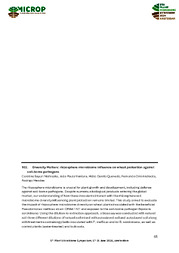Diversity matters: rhizosphere microbiome influence on wheat protection against soil-borne pathogens
Diversity matters: rhizosphere microbiome influence on wheat protection against soil-borne pathogens
Author(s): NISHISAKA, C. S.; VENTURA, J. P.; QUEVEDO, H. D.; ANDREOTE, F. D.; MENDES, R.
Summary: The rhizosphere microbiome is crucial for plant growth and development, including defense against soil-borne pathogens. Despitenumerous biological products entering the global market, our understanding of how these inoculants interact with the rhizosphere soilmicrobiome diversity influencing plant protection remains limited. This study aimed to evaluate the impact of rhizosphere microbiome diversityon wheat plants inoculated with the beneficial Pseudomonas inefficax strain CMAA1741 and exposed to the soil-borne pathogen Bipolarissorokiniana Using the dilution-to-extinction approach, a bioassay was conducted with natural soil three different dilutions of natural soil mixedwith autoclaved soil and autoclaved soil along with treatments containing plants inoculated with P. inefficax and/or B. sorokiniana, as well ascontrol plants (water-treated) and bulk soils. Plants inoculated only with P. inefficax exhibited increased height and root dry mass. As expected,the disease severity index was higher in plants inoculated with the pathogen in soils with lower microbial diversity. Biocontrol efficacy by the P.inefficax was also higher in soils with lower microbial diversity. Beta-diversity analyses indicated significant changes in bacterial and fungalcommunities’ composition when P. inefficax and/or B. sorokiniana were inoculated. Furthermore, a few bacterial and fungal taxa were detectedonly when P. inefficax was inoculated, including members of Flavisolibacter, Chthoniobacter, Massilia, and Streptomyces genus. Inoculationonly with P. inefficax led to an increase in co-occurrence network modularity and when the pathogen is present, in plants inoculated with P.inefficax, there was a decrease in network modularity and number of nodes and an increase in the number of edges. In low microbial soildiversity, when plants are more susceptible to soil-borne pathogens, the inoculation of beneficial bacteria changes the structures of bacterial andfungal communities, preventing pathogen invasion of the rhizosphere.
Publication year: 2024
Types of publication: Abstract in annals or event proceedings
Unit: Embrapa Environment
Observation
Some of Embrapa's publications are published as ePub files. To read them, use or download one of the following free software options to your computer or mobile device. Android: Google Play Books; IOS: iBooks; Windows and Linux: Calibre.
Access other publications
Access the Agricultural Research Database (BDPA) to consult Embrapa's full library collection and records.
Visit Embrapa Bookstore to purchase books and other publications sold by Embrapa.

